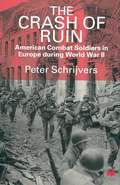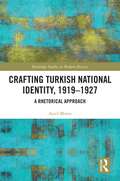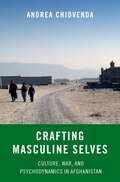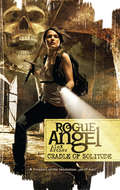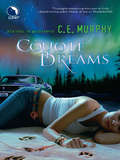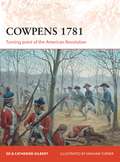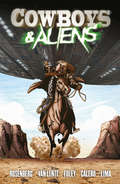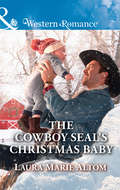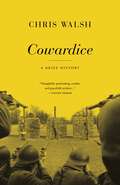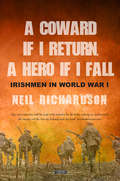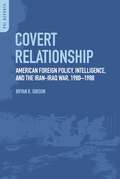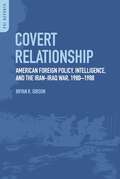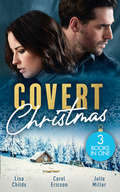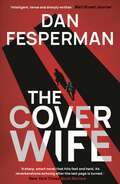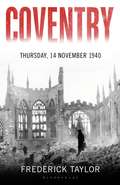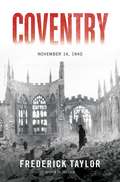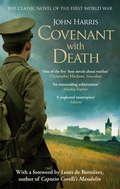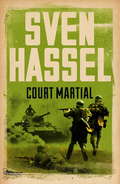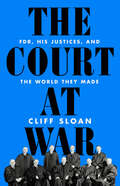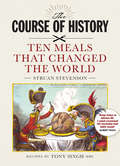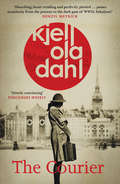- Table View
- List View
The Crash of Ruin: American Combat Soldiers in Europe during World War II
by Peter SchrijversThis book offers a compelling account of how America's combat soldiers experienced Europe during World War II. It paints a vivid picture of the GIs' struggles with its natural surroundings, their confrontations with its soldiers, their encounters with its civilians, and their reactions to uncovering the holocaust. The book shows how these harrowing experiences convinced the American soldiers that Europe's collapse was not just the result of the war, but also of the Old World's deep-seated political cynicism, economic stagnation, and cultural decadence.
Crafting Turkish National Identity, 1919-1927: A Rhetorical Approach (Routledge Studies in Modern History)
by Aysel MorinExamining Mustafa Kemal Atatürk’s Büyük Nutuk (The Great Public Address), this book identifies the five founding political myths of Turkey: the First Duty, the Internal Enemy, the Encirclement, the Ancestor, and Modernity. Offering a comprehensive rhetorical analysis of Nutuk in its entirety, the book reveals how Atatürk crafted these myths, traces their discursive roots back to the Orkhon Inscriptions, epic tales, and ancient stories of Turkish culture, and critiques their long-term effects on Turkish political culture. In so doing, it advances the argument that these myths have become permanent fixtures of Turkish political discourse since the establishment of Turkey and have been used by both supporters and detractors of Atatürk. Providing examples of how past and present leaders, including Recep Tayyip Erdoğan, a vocal critic of Atatürk, have deployed these myths in their discourses, the book offers an entirely new way to read and understand Turkish political culture and contributes to the heated debate on Kemalism by responding to the need to go back to the original sources – his own speeches and statements – to understand him. Contributing to emerging discourse-based approaches, this book is ideal for scholars and students of Turkish Studies, History, Nationalism Studies, Political Science, Rhetorical Studies, and International Studies.
Crafting Turkish National Identity, 1919-1927: A Rhetorical Approach (Routledge Studies in Modern History)
by Aysel MorinExamining Mustafa Kemal Atatürk’s Büyük Nutuk (The Great Public Address), this book identifies the five founding political myths of Turkey: the First Duty, the Internal Enemy, the Encirclement, the Ancestor, and Modernity. Offering a comprehensive rhetorical analysis of Nutuk in its entirety, the book reveals how Atatürk crafted these myths, traces their discursive roots back to the Orkhon Inscriptions, epic tales, and ancient stories of Turkish culture, and critiques their long-term effects on Turkish political culture. In so doing, it advances the argument that these myths have become permanent fixtures of Turkish political discourse since the establishment of Turkey and have been used by both supporters and detractors of Atatürk. Providing examples of how past and present leaders, including Recep Tayyip Erdoğan, a vocal critic of Atatürk, have deployed these myths in their discourses, the book offers an entirely new way to read and understand Turkish political culture and contributes to the heated debate on Kemalism by responding to the need to go back to the original sources – his own speeches and statements – to understand him. Contributing to emerging discourse-based approaches, this book is ideal for scholars and students of Turkish Studies, History, Nationalism Studies, Political Science, Rhetorical Studies, and International Studies.
Crafting Masculine Selves: Culture, War, and Psychodynamics in Afghanistan
by Andrea ChiovendaAgainst the backdrop of four decades of continuous conflict in Afghanistan, the Pashtun male protagonists of this book carry out their daily effort to internally negotiate, adjust (if at all), and respond to the very strict cultural norms and rules of masculinity that their androcentric social environment enjoins on them. Yet, in a widespread context of war, displacement, relocation, and social violence, cultural expectations and stringent tenets on how to comport oneself as a "real man" have a profound impact on the psychological equilibrium and emotional dynamics of these individuals. This book is a close investigation into these private and at times contradictory aspects of subjectivity. Stemming from five years of research in a southeastern province of Afghanistan, it presents a long-term, psychodynamic engagement with a select group of male Pashtun individuals, which results in a multilayered dive not only into their inner lives, but also into the cultural and social environment in which they live and develop. Behind the screen of what often seems like outward conformity, Andrea Chiovenda is able to point to areas of strong inner conflict, ambivalence, and rebellion, which in turn will serve as the seeds for cultural and social change. These dynamics play out in a setting in which what was considered legitimate and justifiable violence on the battlefield has now spilled over into everyday life, even among non-combatants.
Crafting Masculine Selves: Culture, War, and Psychodynamics in Afghanistan
by Andrea ChiovendaAgainst the backdrop of four decades of continuous conflict in Afghanistan, the Pashtun male protagonists of this book carry out their daily effort to internally negotiate, adjust (if at all), and respond to the very strict cultural norms and rules of masculinity that their androcentric social environment enjoins on them. Yet, in a widespread context of war, displacement, relocation, and social violence, cultural expectations and stringent tenets on how to comport oneself as a "real man" have a profound impact on the psychological equilibrium and emotional dynamics of these individuals. This book is a close investigation into these private and at times contradictory aspects of subjectivity. Stemming from five years of research in a southeastern province of Afghanistan, it presents a long-term, psychodynamic engagement with a select group of male Pashtun individuals, which results in a multilayered dive not only into their inner lives, but also into the cultural and social environment in which they live and develop. Behind the screen of what often seems like outward conformity, Andrea Chiovenda is able to point to areas of strong inner conflict, ambivalence, and rebellion, which in turn will serve as the seeds for cultural and social change. These dynamics play out in a setting in which what was considered legitimate and justifiable violence on the battlefield has now spilled over into everyday life, even among non-combatants.
Cradle Of Solitude (Gold Eagle Rogue Angel Ser.)
by Alex ArcherOne mystery could change the fate of a nation… The skeletal remains of a confederate soldier, hidden deep within the Paris Catacombs. The legend of a long-lost Confederate treasure. An aged scrap of paper that reads simply, Berceau de solitude–Cradle of Solitude.
Coyote Dreams (The Walker Papers #4)
by C.E. MurphyInstead of powerful forces storming Seattle, a more insidious invasion is happening.
Cowpens 1781: Turning point of the American Revolution (Campaign #283)
by Ed Gilbert Catherine GilbertThis is a blistering account of the battle of Cowpens, a short, sharp conflict which marked a crucial turning point in the American Revolution. With Lt. Col. Banastre Tarleton and the British troops in hot pursuit, Daniel Morgan, leading a small force of 700 Continentals and militia, chose the Cowpens as the battlefield in which to make a stand. The two forces clashed for barely more than 45 minutes, yet this brief battle shaped the outcome of the War in the South and decisively influenced the conflict as a whole. The authors provide a shrewd analysis of what was perhaps the finest tactical performance of the entire war. Bird's-eye views, vivid illustrations and detailed maps illuminate the dynamism of this clash between two of the most famous commanders of the War of Independence.
Cowpens 1781: Turning point of the American Revolution (Campaign)
by Graham Turner Ed Gilbert Catherine GilbertThis is a blistering account of the battle of Cowpens, a short, sharp conflict which marked a crucial turning point in the American Revolution. With Lt. Col. Banastre Tarleton and the British troops in hot pursuit, Daniel Morgan, leading a small force of 700 Continentals and militia, chose the Cowpens as the battlefield in which to make a stand. The two forces clashed for barely more than 45 minutes, yet this brief battle shaped the outcome of the War in the South and decisively influenced the conflict as a whole. The authors provide a shrewd analysis of what was perhaps the finest tactical performance of the entire war. Bird's-eye views, vivid illustrations and detailed maps illuminate the dynamism of this clash between two of the most famous commanders of the War of Independence.
Cowboys and Aliens
by Scott Mitchell RosenbergArizona. 1873. The ultimate showdown between cowboys and Indians is interrupted… by an alien invasion.
The Cowboy Seal's Christmas Baby: The Cowboy Seal's Jingle Bell Baby The Surgeon's Christmas Baby (Cowboy SEALs #5)
by Laura Marie AltomHIS UNEXPECTED CHRISTMAS SURPRISE…
Cowardice: A Brief History
by Chris WalshCoward. It's a grave insult, likely to provoke anger, shame, even violence. But what exactly is cowardice? When terrorists are called cowards, does it mean the same as when the term is applied to soldiers? And what, if anything, does cowardice have to do with the rest of us? Bringing together sources from court-martial cases to literary and film classics such as Dante's Inferno, The Red Badge of Courage, and The Thin Red Line, Cowardice recounts the great harm that both cowards and the fear of seeming cowardly have done, and traces the idea of cowardice’s power to its evolutionary roots. But Chris Walsh also shows that this power has faded, most dramatically on the battlefield. Misconduct that earlier might have been punished as cowardice has more recently often been treated medically, as an adverse reaction to trauma, and Walsh explores a parallel therapeutic shift that reaches beyond war, into the realms of politics, crime, philosophy, religion, and love.Yet, as Walsh indicates, the therapeutic has not altogether triumphed—contempt for cowardice endures, and he argues that such contempt can be a good thing. Courage attracts much more of our attention, but rigorously understanding cowardice may be more morally useful, for it requires us to think critically about our duties and our fears, and it helps us to act ethically when fear and duty conflict.Richly illustrated and filled with fascinating stories and insights, Cowardice is the first sustained analysis of a neglected but profound and pervasive feature of human experience.
Cowardice: A Brief History (PDF)
by Chris WalshCoward. It's a grave insult, likely to provoke anger, shame, even violence. But what exactly is cowardice? When terrorists are called cowards, does it mean the same as when the term is applied to soldiers? And what, if anything, does cowardice have to do with the rest of us? Bringing together sources from court-martial cases to literary and film classics such as Dante's Inferno, The Red Badge of Courage, and The Thin Red Line, Cowardice recounts the great harm that both cowards and the fear of seeming cowardly have done, and traces the idea of cowardice’s power to its evolutionary roots. But Chris Walsh also shows that this power has faded, most dramatically on the battlefield. Misconduct that earlier might have been punished as cowardice has more recently often been treated medically, as an adverse reaction to trauma, and Walsh explores a parallel therapeutic shift that reaches beyond war, into the realms of politics, crime, philosophy, religion, and love.Yet, as Walsh indicates, the therapeutic has not altogether triumphed—contempt for cowardice endures, and he argues that such contempt can be a good thing. Courage attracts much more of our attention, but rigorously understanding cowardice may be more morally useful, for it requires us to think critically about our duties and our fears, and it helps us to act ethically when fear and duty conflict.Richly illustrated and filled with fascinating stories and insights, Cowardice is the first sustained analysis of a neglected but profound and pervasive feature of human experience.
A Coward if I Return, A Hero if I Fall: Stories of Irishmen in World War I
by Neil RichardsonIRELAND’S FORGOTTEN LEGACY In 1914-1918, two hundred thousand Irishmen from all religions and backgrounds went to war. At least thirty-five thousand never came home. Those that did were scarred for the rest of their lives. Many of these survivors found themselves abandoned and ostracised by their countrymen, their voices seldom heard. The book includes: The first Victoria Cross Leading the way at Gallipoli and the Somme North and South fighting side by side at Messines Ridge Ireland’s flying aces Brothers-in-arms – heart-rending stories of family sacrifice The lucky escapes of some; the tragic end of others The homecoming – why there was no hero’s welcome An important book that opened up the conversation in Ireland about our role in World War I. The paper version of this book also includes over 300 photographs and items of memorabelia from the lives of these brave men and their families.
Covert Relationship: American Foreign Policy, Intelligence, and the Iran-Iraq War, 1980-1988 (PSI Reports)
by Bryan R. GibsonThis modern study of the Iran-Iraq War utilizes newly available primary materials to analyze American policy towards the war and question the veracity of the United States' claims of strict neutrality.The Iran-Iraq War lasted from September 1980 to August 1988, dominating the landscape of the Middle East and polarizing many of the world's nations for nearly a decade. This new work analyzes the United States' policy towards this vicious and extremely costly war, and questions the veracity of America's claims of strict neutrality. The contents of Covert Relationship: American Foreign Policy, Intelligence, and the Iran-Iraq War, 1980-1988 can be broken down into five sections: the conflict's origins, the Carter administration's response to the war, the Reagan administration's actions, changes to American policy during the Iran-Contra Affair, and the collapse of neutrality in the final two years of the war. The author boldly refutes the arguments of other authors about the war, and provides timely and relevant insights regarding American-Iraqi relations in light of the U.S. invasion of Iraq.
Covert Relationship: American Foreign Policy, Intelligence, and the Iran-Iraq War, 1980-1988 (PSI Reports)
by Bryan R. GibsonThis modern study of the Iran-Iraq War utilizes newly available primary materials to analyze American policy towards the war and question the veracity of the United States' claims of strict neutrality.The Iran-Iraq War lasted from September 1980 to August 1988, dominating the landscape of the Middle East and polarizing many of the world's nations for nearly a decade. This new work analyzes the United States' policy towards this vicious and extremely costly war, and questions the veracity of America's claims of strict neutrality. The contents of Covert Relationship: American Foreign Policy, Intelligence, and the Iran-Iraq War, 1980-1988 can be broken down into five sections: the conflict's origins, the Carter administration's response to the war, the Reagan administration's actions, changes to American policy during the Iran-Contra Affair, and the collapse of neutrality in the final two years of the war. The author boldly refutes the arguments of other authors about the war, and provides timely and relevant insights regarding American-Iraqi relations in light of the U.S. invasion of Iraq.
Covert Christmas (Bachelor Bodyguards) / Secret Agent Santa / Military Grade Mistletoe: His Christmas Assignment (bachelor Bodyguards) / Secret Agent Santa / Military Grade Mistletoe
by Lisa Childs Carol Ericson Julie MillerA Christmas escape…
The Cover Wife
by Dan Fesperman'Both gripping and scarily plausible, from the first page to its chilling conclusion, The Cover Wife is a book that demands to be read' Kevin Wignall, author of A Death in SwedenThe latest sophisticated, suspenseful, and intensely human spy thriller from master of the genre Dan Fesperman transports the reader to Paris and Hamburg, and deep into the conspiracy behind the 9/11 attacks.Paris, October 1999. CIA agent Claire Saylor's career has stalled, thanks to unorthodox behaviour in her past. So when she's told she'll be going undercover in Hamburg to pose as the wife of an academic who has published a controversial interpretation of the Quran's promise to martyrs, she assumes the job is a punishment. But when she discovers her team leader is Paul Bridger, another Agency maverick, she realizes there may be more to this mission than meets the eye – and not just for professional reasons.Meanwhile, Mahmoud, a recent Moroccan e´migre´ in Hamburg, has become involved with a group of radicals at his local mosque. The deeper he's drawn into the group, the more he is torn between his obligations to them and his feelings toward a beautiful westernized Muslim woman.As Claire learns the truth about her mission, and Mahmoud grows closer to the radicals, their paths are on a collision course that could have disastrous repercussions far beyond the CIA.
Coventry: Thursday, 14 November 1940
by Frederick TaylorAt a few minutes past seven on the evening of Thursday, 14 November 1940, the historic industrial city of Coventry was subjected to the longest, most devastating air raid Britain had yet experienced. Only after eleven hours of continual bombardment by the German Luftwaffe could its people emerge from their half-sunk Anderson shelters and their cellars, from under their stairs or kitchen tables, to venture up into their wounded city. That long night of destruction marked a critical moment in the Second World War. It heralded a new kind of air warfare, one which abandoned the pursuit of immediate military goals and instead focused on obliterating all aspects of city life. It also provided the push America needed to join Britain in the war. But while the Coventry raid was furiously condemned publically, such effective enemy tactics provided Britain's politicians and military establishment with a 'blueprint for obliteration', to be adapted and turned against Germany. A merciless four-year war of attrition had begun.In this important work of history Frederick Taylor draws upon numerous sources, including eye witness interviews from the archives of the BBC which are published here for the first time, to reveal the true repercussions of the bombing of Coventry in 1940. He teases out the truth behind the persistent rumours and conspiracy theories that Churchill knew the raid was coming, assesses this significant turning point in modern warfare, looks at how it affected Britain's status in the war, and considers finally whether this attack really could provide justification for the horror of Dresden, 1945.
Coventry: November 14, 1940
by Frederick TaylorThe German Luftwaffe's air raid on Coventry, England on the night of November 14, 1940 represented a new kind of air warfare. Aimed primarily at obliterating all aspects of city life, it was systematic, thorough, unconnected to any immediate military goal, and indifferent to civilian casualties. In a single night, roughly two-thirds of the city's buildings were damaged or destroyed as the bombers laid waste to legitimate industrial targets and civilian structures alike. The old St. Michael's Cathedral, a 14th century Gothic structure that burned to the ground that night, still stands in ruins today as a testament to the city's destruction during the raid. Pragmatic British government propagandists would exploit Coventry's perceived status as a "historic town," playing down the city's industrial reputation. This would prove to be a powerful tool, and, as Frederick Taylor shows, was instrumental in tipping public opinion in the then-neutral United States away from isolationism and in favor of help for Britain. But the bombing would also set a dangerous and destructive precedent as Allied air forces would study the Germans' methods in the attack and ultimately employ similar tactics in their equally ruthless and destructive attacks on German cities, eventually leading to the bombing of Hamburg in 1943 and Dresden in 1945 that killed hundreds of thousands, mostly civilians.On the 75th anniversary of the Coventry bombing, acclaimed historian Frederick Taylor brilliantly narrates this momentous act and analyzes its impact on World War II and the moral quandaries it still engenders about the nature of warfare.
Covenant with Death
by John HarrisStirringly told from the view of everyday soldiers, Covenant with Death is acclaimed as one of the greatest novels about war ever written. With a new foreword by Louis de Bernières, author of Captain Corelli's Mandolin.They joined for their country. They fought for each other.When war breaks out in 1914, Mark Fenner and his Sheffield friends immediately flock to Kitchener's call. Amid waving flags and boozy celebration, the three men - Fen, his best friend Locky and self-assured Frank, rival for the woman Fen loves - enlist as volunteers to take on the Germans and win glory.Through ramshackle training in sodden England and a stint in arid Egypt, rebellious but brave Fen proves himself to be a natural leader, only undermined by on-going friction with Frank. Headed by terse, tough Sergeant Major Bold, this group of young men form steel-strong bonds, and yearn to face the great adventure of the Western Front.Then, on one summer's day in 1916, Fen and his band of brothers are sent to the Somme, and this very ordinary hero discovers what it means to fight for your life.'Laden with knowledge yet sparely written, Covenant with Death is the work of an author immersed in the lives of those who fought'The Times'The last line ought to be carved in stone somewhere . . . Find it. Read it. You'll be a better person for having done so'Peter Hitchens, Daily MailAn anti-war book right up there with Remarque's All Quiet on the Western FrontShortlist (The Greatest War Novels of all Time)'Covenant With Death . . . showed with unbearable actuality what happened to a newly formed Sheffield regiment on the first day of the battle of the Somme'Christopher Hitchens, Guardian'The blood and guts, the nightmare stink of cordite . . . appalling realism'The Times'Only one novel about the war since 1945 has the power and feeling of veracity to compare with the works of the 1920s and 30s . . . Covenant with Death by John Harris'The Western Front Organisation'A superb novel'Daily Mirror'John Harris's neglected masterpiece of a novel, Covenant With Death, is the success that it is because it follows a group of Sheffield workers from their flag-waving sign-up to the hecatomb on the Somme'The Atlantic'True and terrible'Observer'An outstanding achievement'Sunday Express
Court Martial (Sven Hassel War Classics Ser.)
by Sven Hassel'They beat me,' whispers the artillery officer, 'Smashed my teeth in, sent an electric current through me. They want me to confess to something I never did.' Sven Hassel and his comrades are fighting on the Finnish front, facing an arctic winter more ferocious than anything they've ever known. But if they survive, they face shipment to Torgau Prison - the centre of Hitler's penal system - where deserters, convicts and anyone showing anti-Nazi sentiments are imprisoned and punished. This could mean arrest, court-martial and execution. Or it could mean torture and starvation. COURT MARTIAL is Sven Hassel's darkest novel and a shocking insight into the cruelty the Nazi regime inflicted on its own people.
The Court at War: FDR, His Justices, and the World They Made
by Cliff SloanThe inside story of how one president forever altered the most powerful legal institution in the country—with consequences that endure today By the summer of 1941, in the ninth year of his presidency, Franklin Roosevelt had molded his Court. He had appointed seven of the nine justices—the most by any president except George Washington—and handpicked the chief justice. But the wartime Roosevelt Court had two faces. One was bold and progressive, the other supine and abject, cowed by the charisma of the revered president. The Court at War explores this pivotal period. It provides a cast of unforgettable characters in the justices—from the mercurial, Vienna-born intellectual Felix Frankfurter to the Alabama populist Hugo Black; from the western prodigy William O. Douglas, FDR&’s initial pick to be his running mate in 1944, to Roosevelt&’s former attorney general and Nuremberg prosecutor Robert Jackson. The justices&’ shameless capitulation and unwillingness to cross their beloved president highlight the dangers of an unseemly closeness between Supreme Court justices and their political patrons. But the FDR Court&’s finest moments also provided a robust defense of individual rights, rights the current Court has put in jeopardy. Sloan&’s intimate portrait is a vivid, instructive tale for modern times.
The Course of History: Ten Meals that Changed the World
by Struan StevensonMany decisions which have had enormous historical consequences have been made over the dinner table, and have been accompanied (and perhaps influenced) by copious amounts of food and wine. In The Course of History Struan Stevenson brings to life ten such moments, exploring the personalities, the issues and of course the food which helped shape the course of history.From the claret consumed on the eve of the Battle of Culloden, through the dinners which decided the fates of George Washington, Archduke Ferdinand and Adolf Hitler, to the diplomatic feasts that decided future relations with Russia, China and the Middle East, each chapter covers every detail, character, decision and morsel which decided the course of history.
The Courier
by Kjell Ola DahlThe international bestselling godfather of Nordic Noir takes on one of the most horrific periods of modern history, in a stunning standalone thriller … NUMBER ONE BESTSELLER‘The Courier is a stylish stand-alone thriller from the godfather of Scandi noir … Ola Dahl ratchets up the tension from the first pages and never lets go’ The Times‘Cleverly braiding together past and present, the who and why of murder and betrayal are unpicked. The detail is impressive’ Daily MailIn 1942, Jewish courier Ester is betrayed, narrowly avoiding arrest by the Gestapo. In a great haste, she escapes to Sweden, saving herself. Her family in Oslo, however, is deported to Auschwitz. In Stockholm, Ester meets the resistance hero, Gerhard Falkum, who has left his little daughter and fled both the Germans and allegations that he murdered his wife, Åse, who helped Ester get to Sweden. Their burgeoning relationship ends abruptly when Falkum dies in a fire.And yet, twenty-five years later, Falkum shows up in Oslo. He wants to reconnect with his daughter. But where has he been, and what is the real reason for his return? Ester stumbles across information that forces her to look closely at her past, and to revisit her war-time training to stay alive…Written with Dahl's trademark characterization and elegant plotting, The Courier sees the hugely respected godfather of Nordic Noir at his best, as he takes on one of the most horrific periods of modern history, in an exceptional, shocking thriller.‘Absorbing, heart-rending and perfectly plotted. Kjell Ola Dahl’s The Courier passes seamlessly from the present to the dark past of WWII. Fabulous!’ Denzil Meyrick‘Skilfully juggling three Oslo timelines — in 1942, 1967 and 2015 — Dahl starts his story with Germany’s occupation of Norway and the work of those who tried to resist, then brings his characters forward to a post-war unravelling of what really happened in those dangerous days — and the traumatic rewriting of personal stories’ The Times Crime Club‘The Courier is very good on the socio-political situation of the time, the relationship between Norway and neutral neighbour Sweden. This is a gritty but ultimately uplifting story. Superbly translated by Don Bartlett’ NB Magazine‘A fascinating, intricate, provocative read, set in motion by events in 1942, and brilliantly highlighting human need and emotions … ‘The Courier’ sent a shiver coursing through me, it is a truly eloquent and rewarding tale, and oh that ending!’ LoveReading‘Written with Dahl’s trademark characterisation and clever plotting, The Courier sees one of Norway’s most critically acclaimed authors at his best … This stunning and compelling wartime thriller is reminiscent of the writing of John Le Carré and William Boyd’ New Books Magazine‘Utterly convincing’ Publishers Weekly‘Kjell Ola Dahl’s novels are superb. If you haven’t read one, you need to – right now’ William Ryan‘More than gripping’ European Literature Network‘The perfect example of why Nordic Noir has become such a popular genre’ Reader’s Digest‘It all comes together, of course, in the kind of masterful, detailed plotting that Dahl is known for … the power of The Courier is how Dahl has given a complex, human face to such an inhuman tragedy’ Crime Fiction Lover‘Atmospheric thriller with lots of great twists and loved the scandi wartime story in particular. Gripping will be recommending to readers’ Edgy Books
